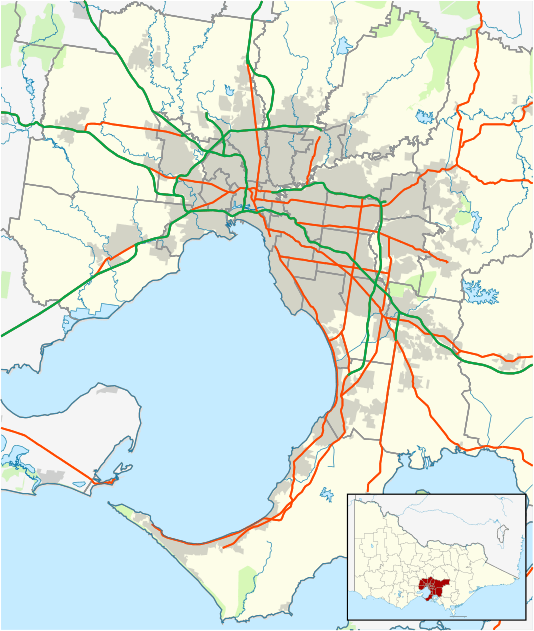Montmorency, Victoria
| Montmorency Melbourne, Victoria | |||||||||||||
|---|---|---|---|---|---|---|---|---|---|---|---|---|---|
 Montmorency Location in metropolitan Melbourne | |||||||||||||
| Coordinates | 37°43′08″S 145°07′34″E / 37.719°S 145.126°ECoordinates: 37°43′08″S 145°07′34″E / 37.719°S 145.126°E | ||||||||||||
| Population | 8,759 (2011 census)[1] | ||||||||||||
| • Density | 2,305/km2 (5,970/sq mi) | ||||||||||||
| Established | 1917 | ||||||||||||
| Postcode(s) | 3094 | ||||||||||||
| Area | 3.8 km2 (1.5 sq mi) | ||||||||||||
| Location | 18 km (11 mi) from Melbourne | ||||||||||||
| LGA(s) | City of Banyule | ||||||||||||
| State electorate(s) | Eltham | ||||||||||||
| Federal Division(s) | Jagajaga | ||||||||||||
| |||||||||||||
Montmorency is a suburb of Melbourne, Victoria, Australia, 18 km (11 mi) north-east from Melbourne's Central Business District. Its local government area is the City of Banyule. At the 2011 Census, Montmorency had a population of 8,759.
Montmorency was named after a local farm, Montmorency Estate, which in turn was named for the town of Montmorency, Val-d'Oise, where the French Enlightenment philosopher Jean-Jacques Rousseau lived briefly. Locals of Montmorency often refer to the suburb as 'Monty', and the nickname is incorporated into some local business names.
History
Merchant Stuart Alexander Donaldson (1812–1867), the first Premier of New South Wales, owned the farming property known as 'The Montmorency Estate' until the 1840s. The first evidence of a township was the building of a Presbyterian church in 1917 in the midst of small rural landholdings. Montmorency Primary School was opened in 1922, the year before Montmorency station was opened on the Hurstbridge railway line. Electricity was connected to the area in 1926. Montmorency Post Office opened around September 1923.[2]
Whilst there was a residential nucleus from the 1920s, most of Montmorency consisted of orchards, dairying, and poultry farms until after the Second World War. The estimated population in 1922 was 200, including weekenders.
In 1950 the estimated population was 600, and facilities extended to two churches, a public hall, a sports ground and a tennis court. By the end of the decade the population had increased fivefold, although still with unoccupied building sites which had fine views. A modern shopping centre and factories had been built.
The suburb had an iconic dairy that was demolished in 2013 to make way for an apartment building which many locals disapproved of at the time as it was the first development of its kind.
Schools
Montmorency Primary School. Recently Rebuilt.
Montmorency Secondary College (Opened in 1969).
Montmorency South Primary School.
St. Francis Xavier Catholic Primary School (Opened in 1932).
Facilities
The main commercial street is Were Street. A three storey high ornamental aeration windmill stands at the corner of Were Street and Rattray Road. The footpaths of Were Street are inlaid with mosaic pictures representing scenes from oral histories of the suburb. This shopping strip is notable for the relatively low proportion of national chain stores and franchises among its businesses.
There is a second business precinct located 1.1 km to the south east of Were Street, on Grand Boulevard, mainly catering to small offices. In Mountain View Road there is an RSL which serves counter meals, a lawn bowls club, and a scout hall with access to the Petrie Park Oval opposite all of these services.
Montmorency Football Club, an Australian Rules football team, competes in the Northern Football League. Its playing field and clubhouse are located at Montmorency Park in the green belt between Para Road and the Plenty River. Lower Plenty Football Club are also in the same league and are also based at Montmorency Park.[3]
Montmorency has hilly parklands adjoining the Plenty River on its western side and several neighbourhood parks, particularly in its south-east sector.
Transport
Montmorency is close to outlying towns and suburbs such as Eltham, Greensborough, Templestowe and Doncaster, for it lies within the main feeder roads to these suburbs. The Box Hill 293, Frankston/Melbourne Airport 901 and Glenroy/Eltham 513 bus routes also service the area.
It lies on the Hurstbridge Line, and it takes around 45 minutes to reach Montmorency Station from the CBD of Melbourne.
Notable people
- Gotye (Musician)
- Brett Wood (Musician)
- Matthew Guy (Leader of the Liberal Party in Victoria. Current opposition leader.)
See also
- Shire of Eltham - A former local government area of which Montmorency was a part.
References
- ↑ Australian Bureau of Statistics (31 October 2012). "Montmorency (State Suburb)". 2011 Census QuickStats. Retrieved 1 July 2012.
- ↑ Premier Postal History, Post Office List, retrieved 11 April 2008
- ↑ Full Points Footy, Northern Football League, retrieved 15 April 2009